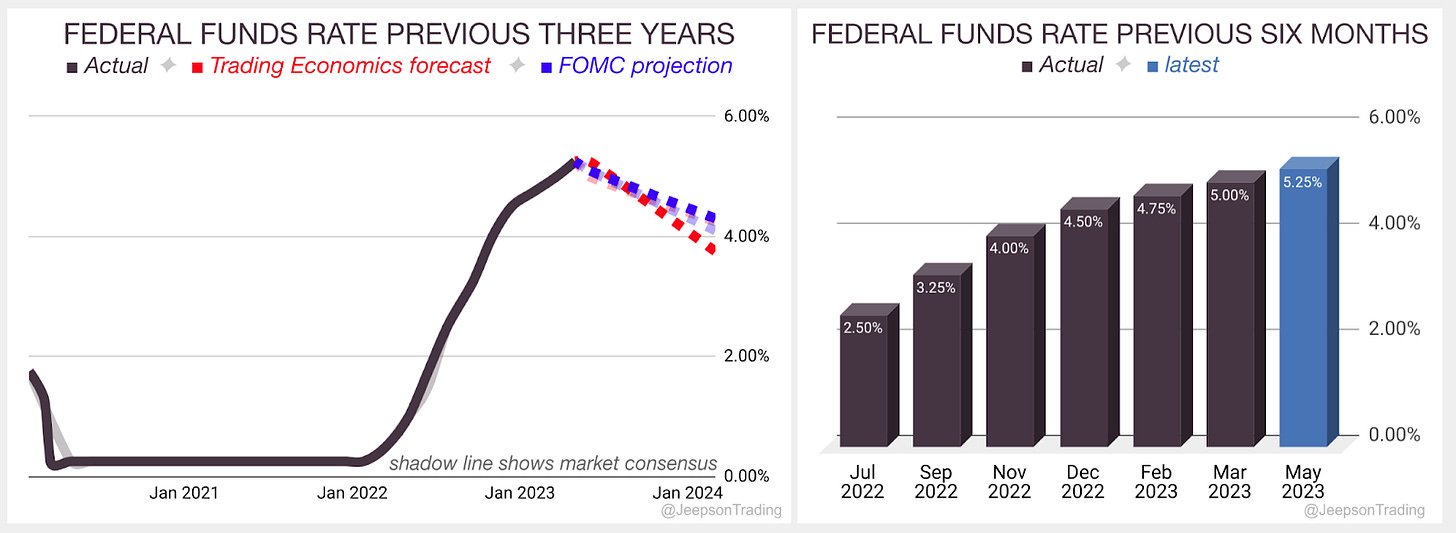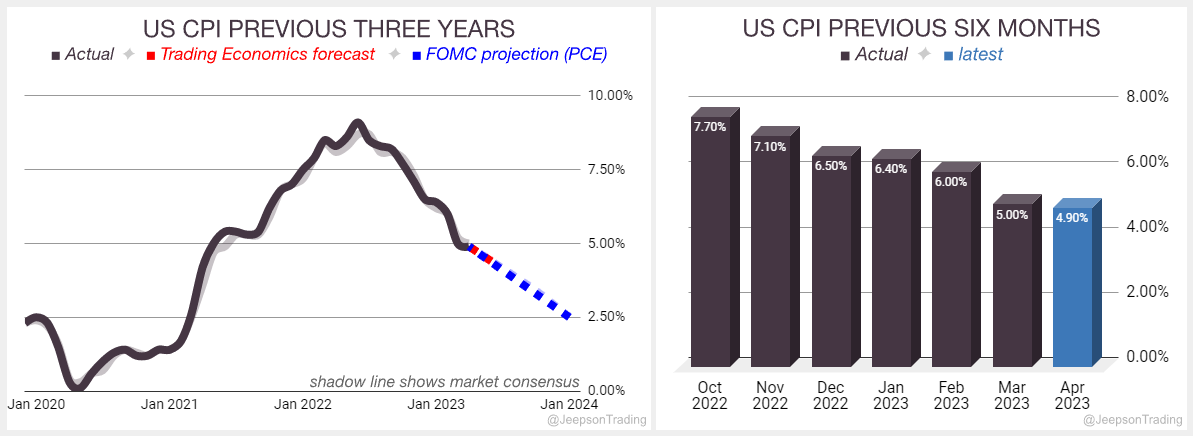US Dollar Forex Reference May (GDP Update)
DERBYSHIRE GB / MAY 29 - This is the US Dollar Forex Reference and contains factual information that has been researched from official sources as well as market commentators. It is intended to be used as a guide to aid in your analysis.
ABOUT THE US DOLLAR
The U.S. dollar is the world’s most widely used currency, a safe haven asset, and a key indicator of global economic health. It is not backed by any physical commodity, but its value is based on faith in the U.S. government.
MONETARY POLICY
The Federal Reserve
The Federal Reserve is the central bank of the United States. The Board of Governors, which has seven members, sets discount rates. The Federal Open Market Committee (FOMC), which has 12 members, sets the levels of central bank money and the federal funds rate. The FOMC members include all members of the Board of Governors, the president of the New York Fed, and four presidents from the remaining eleven Reserve Banks on a rotating basis.
The FOMC decided to raise the federal funds rate by 0.25% on the 3rd of May 2023, to a range of 5.00% to 5.25%. This was the tenth consecutive rate hike, and borrowing costs now match the 2007 high of 5.25%. The Fed signalled a potential pause in the tightening cycle. The central bank also noted that tighter credit conditions could weigh on economic activity.
The next meeting is on Wednesday the 26th of July 2023.
The Federal Open Market Committee‘s May statement contained mixed sentiment and a cautious approach to monetary policy:
The economy grew slowly in the first quarter, but job growth was strong and unemployment was low. Inflation remains high.
The US banking system is strong, but higher interest rates could slow economic growth and hiring. The Fed is watching inflation closely.
The Fed raised interest rates to 5-5/4 percent to combat inflation. The Fed will continue to monitor economic data and adjust policy as needed to achieve its 2 percent inflation target.
The Fed will continue to monitor economic data and adjust interest rates as needed to achieve its goals of maximum employment and 2 percent inflation.
Sources: Federal Reserve, Trading Economics
FOMC Projections
The FOMC revised the projections at their March 22nd meeting and will update them again at the July meeting.
ECONOMIC DATA
Gross Domestic Product (GDP)
In the US, GDP Growth Rate measures the yearly change in the price of goods and services purchased by consumers.
US GDP grew by 1.3% in Q1 2023, higher than expectations of 1.1%. This was driven by consumer spending which climbed 3.8%.
The FOMC projects growth to expand by 0.4% for the full year 2023, down from 0.5% previously. Trading Economics forecasts Q2 2023 growth of 1.5%. The Q1 2023 final report is due on Thursday the 29th of June.
The outlook for growth remains uncertain, but it can be characterised as optimistic improvement. This means that expansion is likely and at higher levels than previously thought.
Sources: Bureau of Labor Statistics, Trading Economics
Inflation
In the US, inflation is measured with the Consumer Price Index (CPI) which measures the yearly change in the price of goods and services purchased by consumers.
Headline CPI for in the US for April slightly fell to 4.9% inflation from the 5.0% in March. This was slightly better than the 5.0% expected. The largest upside move was from ‘gasoline’ which inflated 3.0% in April although has deflated 12.2% over the previous twelve months. The largest downside move was from ‘Utility (piped) gas service’ which deflated 4.9% in April bringing its twelve month deflation to 2.1%. The April report is due on Wednesday the 21st of June.
The FOMC has a PCE projection of 3.3% (prev. 3.4) for 2023 with a fall to 2.5% in 2024. Trading Economics are forecasting 4.4% inflation in Q2 2023 which is unchanged from the previous forecast.
The outlook for CPI can be characterised as a slightly optimistic improvement. This means that a lower rate of inflation is likely but at a slightly lower rate than projected.
Sources: Bureau of Labor Statistics, Trading Economics
Unemployment
In the US, unemployment is measured as the number of people actively looking for a job as a percentage of the labour force.
Total nonfarm payroll employment rose by 253,000 in April
Unemployment rate changed little at 3.4 percent
Employment continued to trend up in professional and business services, health care, leisure and hospitality, and social assistance.
The May report is due on Friday the 2nd of June.
The FOMC has an unemployment rate projection of 4.5% (prev. 4.6) for 2023 with a slight climb to 4.6% in 2024. Trading Economics are forecasting a climb to 3.6% in Q2 2023 which is down from 3.8% previously.
The outlook for US unemployment can be characterised as a slightly optimistic deterioration. This means that a higher rate of unemployment is likely but potentially at lower levels than projected.
Sources: Bureau of Labor Statistics, Trading Economics
GEOPOLITICAL EVENTS
Russian Invasion of Ukraine
The war is having a detrimental effect on the global and US economy by causing higher energy prices, higher food prices, higher inflation and is impacting economic growth.
2021: 92,000 Russian troops are amassed at the Ukraine border and President Putin proposes a prohibition of Ukraine joining NATO which is rejected.
2022: On the 21st of February, President Putin ordered Russian forces to enter the separatist republics in eastern Ukraine and announced recognition of the two pro-Russian breakaway regions (Donetsk People's Republic and Luhansk People's Republic). NATO applied sanctions and scaled them up as the war progressed. Ukraine mounted a counter-offensive which regained lost territory and as winter arrived, a stalemate began.
2023: Russian began a new offensive in January although gained little ground. Ukraine is reported to be preparing for a new counteroffensive during late spring or early summer 2023.
China-US Trade War
The trade war is having a detrimental effect on the global and US economy by causing higher prices for consumers, increased uncertainty for businesses, disrupted supply chains, job losses and is impacting economic growth.
2018: President Trump imposed tariffs on Chinese goods in an effort to reduce the trade deficit and promote domestic manufacturing. China retaliated with tariffs of its own. Negotiations are ongoing to resolve the trade dispute.
2019: Reports showed that the trade deficit increased to record levels in 2018 and the situation escalated through rhetoric. China was accused of currency devaluation (which would make exports more attractive) although the IMF rejected the claim. Negotiations continued throughout the year and a tentative deal was proposed in Q4 which aimed to improve relations and repair the damage that had been caused to both economies as a result of the trade war.
2020: A deal called Phase One was signed at the beginning of the year although the trade targets appeared unrealistic and were missed by year end.
2021: President Biden takes office and reviews the Phase One deal with ongoing talks throughout the year.
2022: The WTO declared the Steel and Aluminium tariffs to be in breach of rules although the Biden administration disputed this and has maintained the trump era tariffs. The disagreement with the WTO is ongoing.
2023: The EU has joined the US in blocking the sale of technology to China that would allow it to produce advanced semiconductor chips.
MARKET NARRATIVES
2023 Debt Ceiling Crisis
The debt ceiling crisis is reducing investor confidence in the dollar and therefore having a negative effect on its value.
The US hit its debt ceiling on the 18th of January 2023 and Secretary Yellen began enacting temporary "extraordinary measures" to pay the bills although this is unlikely to continue beyond the 1st of June. With a split congress (Democrats control the senate and Republicans control the House of Representatives) there is an impasse on getting an agreement to raise the debt limit.
If the ceiling is not raised then the Treasury would begin to default on payments which is expected to result in a global economic meltdown.
Gavin Pearson
Retail trader since 2008
Specialises in forex G7 currencies
Funded account from the5ers.com
Member of the eToro Popular Investors Program
Regular contributor to FXStreet.com analysis and education pages
Jeepson Trading Fund
Returned 27% in 2022 and 8.6% in 2023 Q1
Forex focused
Copy Trading available at eToro
eToro
eToro is a social trading platform
Users can copy trades by clicking the "Copy" button on the profile page
Disclaimer
Past performance is not indicative of future results
Trading involves risk, and you could lose money
-end-







